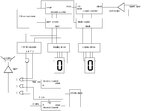wfg42438
Member level 3
- Joined
- Jun 29, 2015
- Messages
- 54
- Helped
- 0
- Reputation
- 0
- Reaction score
- 0
- Trophy points
- 6
- Location
- California
- Activity points
- 620
Im working on a Warning Speedometer project, im currently having trouble thinking about circuit topologies that can be used for frequency multiplication. Once you do the math (refer to the guidelines below) you see that in order to go from frequency to mph you multiply the frequency of interest by 2.88,this is why i want to design a frequency multiplier. Im thinking i can take the output of this frequency multiplier and feed that into a series of Binary counters (TI 74LS90). Then take the output of the counters to a series of BCD to 7-Segment Decoders (74LS47N) and finally to seven segment displays. Please let me know if there are any topologies i can look into to get this done or if this is even possible. Below is a description of the project and to what devices im limited to, any help would be greatly appreciated.
Design a warning speedometer to measure the speed of an automobile. The input to the system is taken from one spark plug. Each pulse from the plug is 0.5 V in magnitude, and occurs once for each 2 revolutions of the engine. An engine speed of 2500 rev/min results in a speed of 60 mph in high gear. The speed is proportional to the revolutions per minute of the engine assuming that no slippage occurs and that the transmission stays in high gear.
Two outputs are required from the tachometer. These are in the form of a visual display of the speed and an audible tone warning of high speeds.
Three 7 segment LED readouts are to display the speed of the automobile to one decimal point accuracy. An audible tone increases in frequency as the velocity increases above 60 mph. The tone is interrupted at a 10 Hz rate. The frequency of the tone is 500 Hz between 60 and 69.9 mph, 2KHz between 70 and 79.9 mph and 5KHz for speeds above 80 mph.
You must drive an 8 ohm speaker with at least 0.5 watts of power.
This unit must be packaged to withstand the automobile environment and should not exeed 6" x 6" x 2".
The chips and other active devices can only be discrete or TTL / CMOS families.
No microprocessors or other PLA, PAL OR OTHER SUCH SPECIAL DEVICES MAY BE USED. PROMS MAY BE USED IF DRIVEN DISCRETELY.
Design a warning speedometer to measure the speed of an automobile. The input to the system is taken from one spark plug. Each pulse from the plug is 0.5 V in magnitude, and occurs once for each 2 revolutions of the engine. An engine speed of 2500 rev/min results in a speed of 60 mph in high gear. The speed is proportional to the revolutions per minute of the engine assuming that no slippage occurs and that the transmission stays in high gear.
Two outputs are required from the tachometer. These are in the form of a visual display of the speed and an audible tone warning of high speeds.
Three 7 segment LED readouts are to display the speed of the automobile to one decimal point accuracy. An audible tone increases in frequency as the velocity increases above 60 mph. The tone is interrupted at a 10 Hz rate. The frequency of the tone is 500 Hz between 60 and 69.9 mph, 2KHz between 70 and 79.9 mph and 5KHz for speeds above 80 mph.
You must drive an 8 ohm speaker with at least 0.5 watts of power.
This unit must be packaged to withstand the automobile environment and should not exeed 6" x 6" x 2".
The chips and other active devices can only be discrete or TTL / CMOS families.
No microprocessors or other PLA, PAL OR OTHER SUCH SPECIAL DEVICES MAY BE USED. PROMS MAY BE USED IF DRIVEN DISCRETELY.


